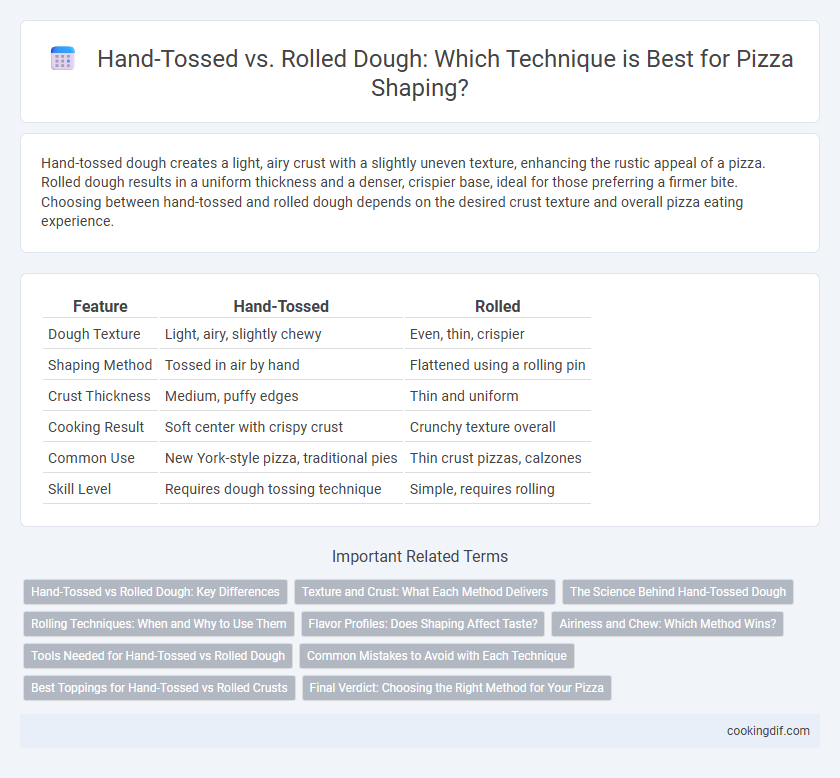Hand-tossed dough creates a light, airy crust with a slightly uneven texture, enhancing the rustic appeal of a pizza. Rolled dough results in a uniform thickness and a denser, crispier base, ideal for those preferring a firmer bite. Choosing between hand-tossed and rolled dough depends on the desired crust texture and overall pizza eating experience.
Table of Comparison
| Feature | Hand-Tossed | Rolled |
|---|---|---|
| Dough Texture | Light, airy, slightly chewy | Even, thin, crispier |
| Shaping Method | Tossed in air by hand | Flattened using a rolling pin |
| Crust Thickness | Medium, puffy edges | Thin and uniform |
| Cooking Result | Soft center with crispy crust | Crunchy texture overall |
| Common Use | New York-style pizza, traditional pies | Thin crust pizzas, calzones |
| Skill Level | Requires dough tossing technique | Simple, requires rolling |
Hand-Tossed vs Rolled Dough: Key Differences
Hand-tossed dough is characterized by its light, airy texture achieved through an open-air tossing technique that promotes even gluten development and a slightly chewy crust, while rolled dough is flattened with a rolling pin, resulting in a denser, thinner base with a uniform thickness. The hand-tossed method allows for natural air bubbles and a crispier outer edge, contrasting with rolled dough's consistent and smoother surface ideal for thinner pizza varieties. Texture and thickness are the main differentiators, influencing baking time and final crust flavor, with hand-tossed pizzas offering a more traditional pizzeria experience and rolled dough catering to quicker preparation and uniformity.
Texture and Crust: What Each Method Delivers
Hand-tossed pizza dough produces a light, airy texture with a slightly chewy crust due to the stretching and aeration during tossing. Rolled dough offers a more uniform thickness and a denser, crispier crust by compressing the gluten structure. Each method influences the final pizza experience, with hand-tossed excelling in softness and rolled delivering a crunchy bite.
The Science Behind Hand-Tossed Dough
Hand-tossed pizza dough develops a unique gluten structure through the stretching and spinning process, which creates an airy, chewy texture with a slightly uneven thickness. The centrifugal force applied during tossing helps to evenly distribute the dough while allowing some areas to thin out, promoting optimal rise and caramelization during baking. This technique preserves gas bubbles formed by yeast fermentation, enhancing the crust's lightness and flavor complexity compared to rolled dough.
Rolling Techniques: When and Why to Use Them
Rolling techniques in pizza dough shaping create uniform thickness and a consistent texture, making them ideal for thin-crust pizzas and large batches requiring speed and efficiency. Hand-tossed dough enhances air retention and produces a chewier, more artisanal crust preferred for Neapolitan-style pizzas. Using rolling methods enables precise control over dough size and shape, which benefits commercial pizzerias aiming for speedy preparation without compromising product consistency.
Flavor Profiles: Does Shaping Affect Taste?
Hand-tossed dough develops a slightly chewier texture and more complex flavor due to the gentle stretching and aeration during tossing, which enhances gluten formation and fermentation. Rolled dough tends to have a denser, more uniform texture with a subtly sweeter taste since rolling compresses the dough, limiting air bubbles and affecting crumb structure. These shaping techniques influence how toppings meld with the crust, ultimately impacting the overall flavor experience of the pizza.
Airiness and Chew: Which Method Wins?
Hand-tossed pizza dough creates a lighter, airier crust with a chewy texture due to its stretch-and-spin technique that traps air bubbles effectively. Rolled dough tends to be denser and less chewy because the rolling pin compresses the dough, reducing air pockets essential for a fluffy crust. For those seeking maximum airiness and a satisfying chew, hand-tossing remains the preferred method.
Tools Needed for Hand-Tossed vs Rolled Dough
Hand-tossed pizza dough requires ample counter space and a flour-dusted surface, relying mainly on skilled hand movements to stretch and shape without additional tools. Rolled dough shaping depends on a rolling pin to evenly flatten the dough and a pastry mat or board to prevent sticking, simplifying the process for even thickness. Both methods benefit from using a pizza peel and stone for transferring and baking, but hand-tossed demands more manual dexterity, while rolled dough emphasizes tool use for precision.
Common Mistakes to Avoid with Each Technique
Hand-tossed dough often suffers from uneven thickness due to inconsistent spinning speed, leading to undercooked or overly crispy edges. Rolled dough may become overly compressed, causing a dense, tough crust that lacks the airy texture desired in pizza bases. Avoid applying excessive pressure in rolling or uneven force in tossing to maintain optimal dough elasticity and uniform cooking.
Best Toppings for Hand-Tossed vs Rolled Crusts
Hand-tossed pizza dough, known for its airy and slightly chewy texture, pairs exceptionally well with hearty toppings like pepperoni, sausage, mushrooms, and bell peppers that complement its thicker base. Rolled crusts, which yield a thinner and crispier foundation, are best suited for lighter toppings such as fresh tomatoes, spinach, olives, and mozzarella cheese to maintain balance without overpowering the delicate crunch. Selecting toppings based on the crust style enhances the overall flavor profile and ensures an enjoyable pizza experience.
Final Verdict: Choosing the Right Method for Your Pizza
Hand-tossed dough shaping offers a lighter, airier crust ideal for traditional, crispy pizzas with a chewy interior, while rolled dough provides a uniform thickness and firmer base suited for thin-crust styles and heavier toppings. The choice depends on desired texture and cooking technique, as hand-tossing promotes better gluten development and airy pockets, whereas rolling ensures consistency and ease of handling. For a classic pizzeria experience, hand-tossed is preferred, but for precision and faster preparation, rolled dough is a practical alternative.
Hand-tossed vs Rolled for dough shaping Infographic

 cookingdif.com
cookingdif.com